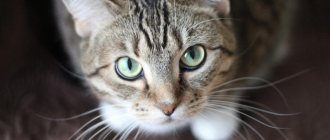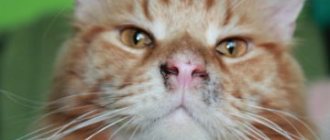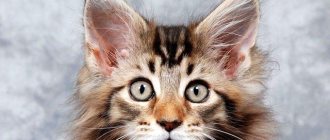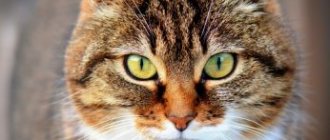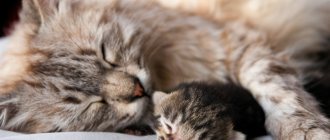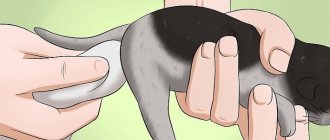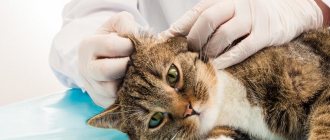What to prepare for gastric lavage for a cat?
Make sure you have everything you need on hand.
Namely: 1. A tool for injecting flushing liquid - a rubber medical bulb (syringe) or an injection syringe without a needle is best suited.
2. Clean or slightly salted drinking water, the recommended concentration is 0.5 teaspoon of salt per liter of water.
Often a solution of potassium permanganate (potassium permanganate) is used for washing. Despite the high antibacterial activity of this product, today many veterinarians categorically do not recommend it, since undissolved crystals can cause a chemical burn to the gastric mucosa. If you still use potassium permanganate, then take only a pale pink solution that has been filtered from the crystals.
3. Liquid with enterosorbent (needed in the second stage).
Before cleaning your cat's stomach, you also need to prepare an absorbent solution. If you plan to clean your cat’s stomach with activated carbon, you will need 4–5 tablets per 500 ml of water; they must first be crushed into powder.
Activated carbon is the simplest and most affordable remedy, but in fact, there are now new generation enterosorbents that form a much more homogeneous solution and can cleanse the stomach just as effectively. Among the examples of such drugs we can name “Polysorb”.
4. Container for vomit.
5. Clamps for paws. These can be pieces of gauze or any other pieces of fabric that can be used to secure the paws.
6. A bath towel large enough to wrap the cat during the procedure.
Rinse your cat's purulent eyes: the main thing is not to harm
Before visiting the clinic, veterinarians categorically do not recommend rinsing your pet’s eyes with potassium permanganate and medicinal solutions (especially antibiotics).
After this, it will be much more difficult for the doctor to make a correct diagnosis - the clinical picture will be blurred. Therefore, the best remedy in this case is ordinary boiled water.
If the diagnosis has already been made at a veterinary hospital, then treatment will be prescribed there. They will tell you how to wash a cat’s purulent eyes if there is a bruise or injury to the eyelid (for this you need a 3% solution of hydrogen peroxide).
They will explain how and with what to wash a cat’s eyes from pus with purulent conjunctivitis: a 2% aqueous solution of boric acid will help. By the way, you can prepare it yourself: take 2 teaspoons (without top) of boric acid in half a glass of water.
In case of blepharitis - before washing the mustachioed eyes - the purulent crusts are softened with Vaseline oil. The list of things to use to wash a cat's eyes if they fester: saline solution, a weak solution of potassium permanganate (potassium permanganate) or furatsilin, chlorhexidine, as well as herbal decoctions with antibacterial properties (chamomile, calendula, St. John's wort, sage). And, of course, tea leaves.
Gastric lavage for cats: algorithm of actions
Attention! Flushing the stomach is allowed only in situations where the cat is conscious. Otherwise, there is a risk that the animal will choke on vomit.
Also, a direct contraindication to the procedure is gastrointestinal bleeding, which is characterized by vomit and black fecal discharge. You should not provoke vomiting in case of poisoning with acid or alkali, as this can lead to perforation of the affected wall of the esophagus or stomach.
It is most convenient to rinse in the bathroom. Before beginning any treatment, put on thick, long-sleeved clothing and then do the following:
1. Secure the cat by wrapping it tightly and neatly in a towel or blanket so that only the head and neck remain outside. It is best to attract an assistant who will hold the “cocoon” with the cat, pressing her back to you. If you are working alone, then also try to hold the cat not sideways, but with its back to you - this makes it easier to reach both the container with water for rinsing and the cat’s mouth.
2. Insert the end of the syringe or syringe into the side of the animal’s jaw, selecting the space between the teeth.
3. Pour in the solution.
Important: the total volume of fluid administered should not exceed 400 ml for an adult. Otherwise, the intestinal pylorus will open, and toxic substances will accelerate their transit through the body.
4. Induce vomiting to empty the cat's stomach. To do this, you can press 1-2 times on the root of the animal’s tongue. True, this is quite difficult to do, and most often, from the stomach being full of liquid, vomiting will begin on its own. If this does not happen, then you can simply massage the cat in the abdomen or rock it from side to side.
5. Inject absorbent liquid. Give it time to work (10-15 minutes) and then induce vomiting again.
6. Continue rinsing until the applied solution comes out almost clean.
Flushing a cat's stomach is an emergency measure that should be used only if it is not possible to see a doctor. But even after providing first aid, a visit to the veterinary clinic is not canceled. Only a specialist can conduct appropriate research and prescribe further treatment.
Elena Shlykova
What canned food tastes best for cats?
RESEARCH ATTENTION! You and your cat can take part in it! If you live in Moscow or the Moscow region and are ready to regularly observe how and how much your cat eats, and also remember to write it all down, you will receive FREE SET OF WET FOOD.
Project for 3–4 months. Organizer - Petkorm LLC.
Want to participate? Call!
There is a standard set of emergency animal care skills that every owner should master, because, more often than not, time ticks by in minutes. There are several options in which it is necessary to rinse a cat’s stomach - accumulation of hair swallowed during licking or poisoning, if in the first case you have time to think, then in the second, delay can cost your life.
In what cases is gastric lavage contraindicated?
In some situations, therapeutic gastric lavage is contraindicated for animals. In what cases is gastric lavage contraindicated:
- if the cat has been poisoned by coagulants, pesticides (rat poison);
- more than 2-2.5 hours have passed since the poisoning;
- the pet is unconscious;
- in case of poisoning with acids, alkalis;
- if poisoning is manifested by severe neurological disorders, seizures, convulsions;
- with internal gastric bleeding (feces, dark brown, black vomit);
- ulcerative lesions of the stomach;
- with severe depression of respiratory function and cardiac activity.
You should not rinse your cat’s stomach if the animal has severe difficulty swallowing. Most likely, the reason is a foreign body in the esophagus and the fluid will push the foreign body into other parts of the gastrointestinal tract.
If you have any doubts about gastric lavage for your cat, we recommend consulting with your veterinarian.
Gastric lavage for intestinal blockage
With partial blockage of the intestines, constipation, vomiting or urge, loss of appetite and primary signs of intoxication are observed. Blockage of the intestines by hair is perhaps the most common case that the owner of a long-haired pet may encounter. If the animal appears active, feed it wool-dissolving paste.
In an advanced situation, you will need to cleanse the cat's stomach of hair by rinsing it. To carry out the procedure at home you will need:
- A syringe, a syringe without a needle or a tube, part of the IV system will do. After cutting the tube, melt it down to avoid injury.
- Clean water in which absorbent or special paste can be dissolved.
- Gauze cuts.
- Large towel.
Before starting the procedure, you need to protect yourself and immobilize the cat:
- Wear long sleeves.
- Tie the animal's paws and wrap it tightly in a towel.
- Place the tube under your tongue and start pouring in the liquid.
- The maximum allowable amount of liquid for an adult cat is no more than 500 ml.
- Pour in half the liquid and try to make the cat vomit. If there is no urge, repeat the procedure.
- Make sure that when vomiting, all the mass comes out freely. Once the fur is out of the stomach, carefully untie the cat and leave it alone.
- 20–40 minutes after the procedure, the pet needs to drink an enveloping agent, milk or egg white.
Important! If you observe signs of severe intoxication or vomiting of feces, immediately take the animal to the veterinarian. Symptoms indicate intestinal volvulus, which is fatal if delayed.
How to rinse a cat's stomach at home
Most poisonings require an immediate visit to the veterinarian, but how to flush a cat’s stomach when it is impossible to get to a hospital? To cleanse the muscular organ of toxic substances, you will need the following items:
- 2 glasses of warm boiled water;
- a tube made of rubber, flexible plastic (cut off from the drip system);
- syringe without needle, teaspoon.
You need to pour water into your stomach carefully. The cat is carefully secured, its mouth is opened, and a piece of rubber tube is inserted under the tongue. Using a spitz, they begin to slowly introduce boiled water into the other end of the tube. But how to rinse a cat’s stomach at home when there is no syringe or tube? Add liquid easily using a teaspoon. To do this, the animal's muzzle is firmly fixed and liquid is poured into the toothless space, which is located on the sides of the jaw. For a better swallowing effect, it is recommended to gently stroke the cat's throat. Before you rinse your cat’s stomach at home, you need to make sure that the pet is conscious and can swallow the liquid on its own.
It is allowed to use no more than 500 ml of liquid in one procedure; a larger volume of water will cause the liquid to leak into the intestines along with toxins. How to rinse a cat's stomach to induce vomiting faster? To speed up the onset of vomiting, add a little table salt or sodium bicarbonate (soda) to the water. You cannot use a solution of potassium permanganate, even a very weak one. If potassium permanganate crystals get on the mucous membrane of the esophagus or stomach, a burn will occur. How to rinse a dog's stomach, read here.
Gastric lavage in case of poisoning
You need to understand that poisoning with stale food and poisons are completely different situations that require appropriate help. When food poisoning occurs in a cat:
- Weakness.
- Vomiting and diarrhea.
- Slight decrease in body temperature.
- Kosha refuses to eat, but not to drink.
In case of severe poisoning, the above symptoms are more active, the animal’s mucous membranes turn pale, saliva flows heavily, and loss of consciousness may occur. If the animal is conscious, gastric lavage with potassium permanganate is required.
Be careful! The potassium permanganate solution should be barely pink. After preparing the rinsing liquid, partially drain it into a clean container. It is important to prevent manganese crystals from entering the stomach.
The washing solution is prepared from absorbent (4 tablets of coal), table salt (1/2 teaspoon) and soda (2-3 g), dissolve the resulting powder in 500 ml of warm water. Washing is done 3-4 times. After the vomit has become transparent, prepare a thick paste from crushed activated carbon or any absorbent that you have on hand. Give the cat a drink and let the medication take effect. Monitor your body temperature carefully and if it drops, call your veterinarian.
If an animal at home loses consciousness, the chances of quality help are reduced to zero. You simply drown the animal by pouring the solution down its throat. If you have a steady hand, you can try inserting the tube into the cat's stomach. The measure is relevant only for the introduction of fast-acting absorbents.
- Lay the animal on its side and secure it.
- Arm yourself with a flashlight, coat the edge of the tube with Vaseline and begin inserting the “probe” into the esophagus.
- Take your time and start over if the tube hits something.
- Be sure to check where the tube got into by blowing into it. If the tube is in the stomach, the abdominal cavity will swell.
- Once the tube is in the stomach, administer absorbents. This will give you a little time and you will have time to take the animal to the doctor.
Important! Filling the stomach with liquid can cause the pyloric valve to open, after which toxic substances enter the intestines.
What you can and cannot rinse your stomach with
Gastric lavage for cats can generally be called an emergency measure. This procedure is used if you need to quickly cleanse the body of toxins, but there is no way to call a veterinarian or take the animal to a clique.
For washing, specially prepared adsorbing solutions are used, which are prepared at home. Do not rinse the stomach with too concentrated solutions, a solution of potassium permanganate in which there are crystals of potassium permanganate.
For cats, it is dangerous to lavage the stomach with a large amount of liquid, which can lead to expansion of the pyloric opening and the contents of the stomach will penetrate into the intestine.
To lavage a cat's stomach, use:
- saline solution
- potassium permanganate (potassium permanganate);
- soda solution;
- hydrogen peroxide.
For washing, solutions with adsorbing substances are also used (20-30 g of activated carbon per 125 ml of water), as well as 0.5% tannin. You can also prepare a composition for rinsing, which perfectly helps overcome the symptoms of intoxication.
We will need:
- 4 tablets of activated carbon, crushed into powder;
- a quarter teaspoon of table salt;
- 2-3 g of soda;
- 500 ml water.
All ingredients are added to warm water and mixed well until dissolved. The cat is given this mixture four to five times until the vomit becomes clear.
Water can be used for gastric lavage to remove hair or for mild poisoning. The cat is given warm, room temperature water. Two ordinary glasses of water are enough to achieve the effect.
You can add an adsorbent to the water, a special paste for removing hair from the body, and a small amount of salt.
To reduce the absorption of poisons into the gastric mucosa, add 2-3 egg whites to a liter of water. Protein water has a soft enveloping effect and protects the mucous membranes of the gastrointestinal tract.
Potassium permanganate is an effective remedy that is often used for gastric lavage in cats.
The solution should be slightly concentrated, light pink in color. Just a few crystals of potassium permanganate are enough.
Baking soda is used to prepare a solution that is used to rinse the stomach of cats in case of poisoning. One teaspoon of soda is dissolved in 500 ml of warm water. Stir well and pour in small portions until a gag reflex appears.
Veterinarians recommend using saline solution for gastric lavage. Helps quickly induce vomiting. To prepare the solution you will need:
- table salt - a small heaped teaspoon;
- boiled warm water – 500 ml.
How to help a cat with poisoning if gastric lavage is contraindicated
If petroleum products, alkali or acid are ingested, forced vomiting or gastric lavage is contraindicated for the animal. To relieve primary intoxication, the animal must:
- Drink a 3% hydrogen peroxide solution. To prepare the solution, use hydrogen peroxide diluted with saline solution or clean water. The resulting substance is given to the cat three times in an amount of 5–15 ml, with a break of 10–15 minutes.
- In case of acute intoxication, drink root emetic syrup at a dosage of 1 ml per 1 kilogram. As a complication, root emetic has a toxic effect on the heart muscle, making the measure risky.
- A solution of hydrogen peroxide provokes vomiting and destroys the toxic substance, which must be removed from the body using sorbents - activated carbon, Atoxil, Enterosgel.
- The absorbent is drunk twice with a break of 20–30 minutes, after which the stomach is washed.
>How to rinse the stomach of a dog or cat at home in case of poisoning or foreign body
How to wash a kitten's eyes?
The washing procedure is quite responsible. Therefore, approach manipulation with all seriousness. Be sure to wash your hands with soap (also wash after the procedure). Prepare a solution for treatment. Cut the bandage and fold it into small pads 4-6 layers thick. Cotton wool and cosmetic pads should not be used: small fibers may remain in the eye, which will further aggravate the situation. A clean pad should be used for each eye.
The kitten must be held tightly so as not to inadvertently injure it. The best option is to perform the manipulation with an assistant. The gauze pad must be moistened with the prepared solution. Then, moving from the outer edge of the eye to the nose, wipe the kitten’s eye. Each wipe should be done with a new piece of gauze.
The eye wash procedure is painless, but the kitten may be scared. Therefore, after performing the manipulation at home, you need to calm the baby down and give him some treat.
Pay close attention to your pet, its health depends on you!
Signs of poisoning
The symptoms of poisoning in cats are varied, but only a few of them may appear. Common signs of poisoning in cats:
- nausea, which is expressed by the pet licking its nose very often, while smacking its lips;
- salivation;
- vomit. It may be mixed with bile or blood, or it may be without impurities;
- diarrhea;
- lack of appetite;
- rapid breathing, often shallow;
- abdominal pain, which may be accompanied by meowing, or may only be noticeable when pressing on the abdomen;
- temperature increase;
- pupil dilation. Sometimes the third eyelid becomes noticeable in poisoned animals.
In addition, the behavior and general condition of the pet changes. There may be lethargy or, conversely, overexcitation. Coordination of movement may be impaired. In severe cases, tremors, seizures, and paralysis may occur.
If symptoms are detected and the cat may have been poisoned, then before you start doing anything at home, you need to make sure of this. Such symptoms may indicate not only poisoning, but also other serious diseases. It is important to find out whether the cat has been poisoned or not as quickly as possible. It is necessary to analyze what could have caused it. If the cause is not found, it is better to immediately contact a veterinary clinic for diagnosis and treatment.
Treatment for poisoning in cats differs from treatment for other diseases with similar symptoms. If you draw the wrong conclusion, you can do harm and waste time. Particular attention should be paid to kittens, especially when the kitten has been poisoned by a large dose of poison.
Treatment of poisoning in cats
Treatment of poisonings and animals should always begin with stopping the effect of poisons on the body. Toxic substances are removed from it by washing the stomach and intestines, prescribing emetics and laxatives, and adsorbents by the veterinarian. Sometimes it is advisable to use an antidote, that is, a substance that neutralizes the poison.
After this, symptomatic treatment is necessary.
The owner of the injured animal does not always have experience in carrying out such procedures, and it is not worth risking the health of the pet by doing this for the first time. Therefore, it is necessary to seek help and take all rescue measures promptly.
If you still decide to act on your own, then you need to rinse the cat’s stomach with plenty of water with the addition of salt or baking soda. You can also do an enema to remove toxins. This procedure, when applied to animals, is more effective and convenient than gastric lavage.
Apomorphine and ordinary potassium permanganate, diluted in boiled water to a slightly pink color, are most often used as emetics. Such products should always be present in your first aid kit.
As for adsorbents, the best and most affordable of them is activated carbon. It should be given at the rate of one tablet per 10 kilograms of animal weight. That is, in most cases it will be enough to crush half a tablet and pour it, diluted in water, using a syringe without a needle into the cat’s mouth.
After these measures, when you see that the cat is feeling better, you need to use mucous decoctions or coating substances. Egg whites, rice broth, oatmeal, and tannin solution are suitable.
It is important that the cat drinks a lot to speed up the removal of toxic substances from its body. In case of poisoning, dehydration of the body always occurs, so if the animal stays on the same water for a day or two, nothing bad will happen. After this, let him eat little by little, preferably liquid food.
How to get rid of fur in a cat's stomach
It is absolutely natural that a cat’s hair can come out in two ways – through vomit or through feces. All means are aimed at one way or another to solve the problem. Let's talk about the most effective ways to rid your cat of a lump in the digestive system.
- Walk outdoors. The fact is that a cat can heal itself. She eats special types of plants that can make her vomit. If you live in an apartment, your cat may not be able to meet its needs. Go to the country house, garden or garden plot and let your pet walk in the grass. He will find his own healing.
- Grown grass. If you don’t have the opportunity to go into nature, you can grow such grass at home, right in the conditions of a city apartment. Vet stores sell seeds of a special herb that causes cats to vomit. Plant them in a pot and place them on the windowsill. As soon as the seeds begin to germinate, the cat itself will begin to feast on the offered treat and will be very grateful to you. If you don’t have time to grow, you can buy a pot of already sprouted sprouts there.
- Specialized feed. These are products that will help you remove hair from your stomach and intestines naturally. There are foods on sale that are designed to remove fur from feces. They contain a sufficient amount of oil, which envelops the walls of the stomach and intestines, after which it gently removes even the largest hairball. There is no need to feed your pet this food all the time, only during the molting period or once a month for prevention. Usually cats like this kind of food.
- Phytomines for distilling wool. To remove a hairball from the intestines, you can use phytomines. This is an excellent drug that copes well with intestinal obstruction. It removes not only hair, but also stuck pieces of paper, bones and other foreign objects. It is based on a collection of various medicinal herbs that are beneficial for digestion.
- Pads with vegetable oils. There are special treats on sale for the pickiest cats. They are pads containing special flavored oils. Cats eat these pads with pleasure - they can be flavored with chicken, beef, or fish. The oils gently coat the walls of the stomach and remove the hair ball with feces.
- Paste. In pet stores or veterinary pharmacies you can find a special paste that is mixed with the main food. It has a pleasant taste and smell, so most pets do not refuse it.
- Petrolatum. If veterinary pharmacies and stores are far away, but you want to help the animal now, you can use simple Vaseline. Buy pure Vaseline at the pharmacy and pour about one teaspoon into the animal's throat using a syringe without a needle. This will help lubricate the stomach and the fur will come out without much effort.
Remember that you are responsible for those you have tamed. After all, animals are like children, they cannot talk about their symptoms and are completely dependent on you. Even if the pet does not show external signs of hair formation in the stomach, take preventive measures to cleanse the cat’s digestive tract.
how to get rid of ear mites on a cat
About stomach cleansing products
Let us recall that once wild animals, cats, can cleanse their stomachs themselves with the help of grass. This is done by those pets who have access to it. But in winter, even cats walking outside are limited in this opportunity. This is why growing specialty weed should be considered by every caring owner. Its seeds can be purchased at a pet store, sown in a pot, and after 7 days the cat will be able to eat it and clean its stomach.
The second option for cleansing your pet’s stomach of fur is special therapeutic and prophylactic food. Their peculiarity is that they contain an increased portion of plant fibers and oils that envelop the stomach and help cleanse the digestive tract. After consuming such food, the fur, along with feces, is removed from the pet’s body without causing irritation or discomfort.
Phytomines are mineral complexes from plant extracts for cleansing cat stomachs. As a rule, they include hill solyanka, violet, celandine, plantain, licorice root, and centaury. From the age of two months, kittens are allowed to be given phytomins. Such products are gentle on the digestive tract and do not cause irritation.
Malt paste is a natural and easily digestible product for removing hairballs. Veterinarians call it the best product for cleaning cat stomachs, because it consists of oils, plant fibers, and ash substances. This product not only cleanses, but also improves the intestinal microflora and envelops its walls.
Cleansing treats are an option for true gourmet cats; they are chosen by responsible owners who want to pamper their pet and take care of the condition of its stomach. They look like crispy pillows. The healthy filling inside such delicacies serves as a cleansing agent. Such treats for cats taste like vegetables, fish, and meat, meaning the owner can choose the one that suits the pet’s preferences.
If the animal’s stomach is in poor condition and suffers from constipation, then the best cleaning option is Vaseline oil. It must be injected into the pet's mouth using a syringe without a needle. The product coats the walls of the stomach, promotes fur, and protects the cat from painful bowel movements.
First aid for cat poisoning ➠ Veterinarian advice
Poisonings other than food poisoning often require medical intervention and the administration of an antidote. Only a qualified specialist can find out which antidote to administer and correctly calculate the dose.
What to do if a cat is poisoned and what first aid to provide:
- When bitten by insects or snakes, apply ice to the bite site. This will narrow the blood vessels and prevent the poison from spreading further throughout the body.
- If the poison gets on the skin, the pet must be washed under running water.
- If an animal has inhaled harmful substances, immediately take it out into fresh air.
- If acid enters the stomach, vomiting should not be caused.
- In case of poisoning by rat poison, it is necessary to find out its composition, and only after that can an antidote be used. If the venom contains an anticoagulant, vitamin K is prescribed intramuscularly; if the venom contains vitamin D3, diuretics are prescribed. If the composition of the poison is unknown, then vitamin K and diuretics are used in combination. Only a veterinarian can prescribe the dosage and treatment regimen, depending on the weight and condition of the animal.
- In case of poisoning with isoniazid (a drug for tuberculosis), which is used by dog hunters, vitamin B6 is used as an antidote.
If the cause of intoxication is rat poison or isoniazid, it is necessary to rinse the stomach and give a laxative, just as for food poisoning.
If a cat is poisoned, then before treating it at home and providing first aid, it is advisable to contact a qualified specialist and clarify what can be used and in what doses in case of poisoning with a specific chemical.
After providing first aid for any poisoning, it is necessary to examine the animal in a veterinary clinic. Your pet may require additional therapy to recover.
When should you induce vomiting?
It is necessary to provoke an eruption of stomach contents in the following cases:
- Ingestion of bait for rats and mice, poison for insects. In such a situation, rinsing should be done immediately.
- Ingestion of inedible foreign objects and low-quality food products into the stomach.
- Drug poisoning. Analgesics, antispasmodics and anti-inflammatory medications are especially harmful to cats.
- Ingestion of cleaning powders, dishwashing gels, floor washing gels and other household chemicals. It is better if in this case assistance is provided by a veterinarian, since most chemicals contain acids and alkalis.
Cat owners begin to get confused if a very young animal is poisoned, and do not know how to make the kitten vomit. In fact, exactly the same products are used for a small kitten as for an adult pet, but the dosage of active ingredients should be several times less.
When is it forbidden to rinse your pet's stomach at home?
Regardless of what caused the intoxication of the body, a veterinarian should assist the cat in case of poisoning. If possible, you should contact a veterinary clinic as soon as possible. If visiting a doctor is possible only after some time, it is necessary to take measures aimed at reducing the absorption of poison into the blood.
What to do if your cat is poisoned:
- Find out the cause of poisoning;
- Remove the source of poisoning from the pet’s access area;
- Rinse the stomach. To do this, use clean water, which is poured into the cat’s throat using a large syringe without a needle. It is allowed to pour in 250-500 ml of liquid at a time. After this, vomiting is induced by pressing on the far part of the tongue;
- Before washing the stomach, you need to give a sorbent - activated carbon is suitable for this purpose. It prevents toxic substances from being absorbed into the walls of the stomach, taking them onto itself. No more than half of one tablet should be given at a time. It must be crushed, diluted with a small amount of water and poured deep into the throat. Vomiting can only be induced after a few minutes. It is necessary to wait for the sorbent to absorb toxic substances;
- If several hours have passed since the poisoning, you can do an enema to remove toxic substances from the intestines. The volume of liquid introduced into the rectum should not exceed 50 ml;
- To avoid dehydration, your cat needs to be given water. If you refuse water, you should force drink, using a syringe without a needle. You need to drink little by little, with an interval of 15-20 minutes. If vomiting occurs frequently, it will be good if, instead of plain water, you give your pet a saline solution, which helps restore the water-salt balance.
If you are vomiting, you should not use antiemetic drugs. Vomiting is a natural reaction of the body in which harmful substances are removed from the stomach.
There are cases when gastric lavage in cats/dogs is prohibited:
- The animal is unconscious.
- The poisoning was such substances as kerosene, turpentine, barbiturates and opiates, gasoline, acids and alkalis (household chemicals).
- The owner is not sure he can handle it.
It is very good if pet owners have a veterinarian on duty, who can provide conversational advice and suggest the course of action.
Pets can accidentally become poisoned by household chemicals, eat spoiled food or a poisoned mouse, or simply ingest too much of their own hair. In this case, you need to know how to help the animal, because in case of acute poisoning, the ability to rinse the stomach can save the unfortunate person.
Gastric lavage is a medical treatment procedure, the technique of which should be mastered by all people with pets. In case of acute poisoning, it can save the animal’s life. In this article, we looked at how to rinse a cat’s stomach at home, what are the indications and contraindications for this procedure.
It is important to know how to rinse the stomach at home. After all, the need for this may arise due to intoxication or diseases of the gastrointestinal tract. In some cases, stomach cleansing does not require hospitalization of the patient; it can be done at home. But first you need to get advice from a specialist regarding how to properly cleanse the stomach with an enema and probe from waste, toxins and other harmful substances. How to cleanse the stomach and intestines of them?
Symptoms of poisoning
Depending on what the cat was poisoned with, signs of intoxication may differ significantly from each other. When a cat eats rotten or sour products, the animal experiences vomiting with mucus or blood, diarrhea with a foul odor, and refusal to eat. The animal looks a little lethargic, lies down more, loses interest in games, and its body temperature is elevated. As a rule, such poisoning is not considered dangerous and in most cases goes away on its own after some time. But if after several days the cat still does not show the desire to eat and move, the diarrhea and vomiting do not go away, the animal may die from dehydration. In this case, it is necessary to lavage the cat’s stomach, and then show the furry pet to a veterinarian.
Intoxication with poisons and chemicals is accompanied by more pronounced symptoms:
- the animal often vomits, and the vomit may contain an admixture of blood and bile;
- the cat completely refuses food, in some cases even water;
- the pet’s condition is depressed, lethargic, the pupils are dilated;
- the cat's breathing is heavy, frequent, heartbeats are not clearly audible;
- swelling of the joints and an increase in abdominal volume may be observed;
- decreased body temperature;
- blood leaks from the nose, mouth, anus;
- saliva production increases;
- There is diarrhea (sometimes black).
The presence of blood in vomit, feces, or discharge from the eyes, nose, or rectum indicates internal bleeding. This complication occurs when anticoagulants (toxic substances used to bait mice and interfere with the process of blood clotting) enter the cat’s body. In this case, gastric lavage for the cat is unacceptable; the best solution would be an urgent visit to the veterinarian. Recommendations on what to do if your cat ate a poisoned mouse.
If a cat’s stomach is firmly clogged with hair, and the animal is unable to get rid of the problem on its own (by vomiting), the owner notes the following signs:
- refusal of food;
- pallor of the mucous membranes;
- depressed state, desire to hide in a hard-to-reach place;
- constipation.
Most cats get rid of swallowed hair by vomiting, but sometimes the animal is not able to remove tightly compressed clumps. To help your pet and avoid unpleasant consequences, you need to know how to rinse a cat’s stomach.
The main indications for cleansing the stomach of a cat
Gastric lavage for cats is most often performed in emergency situations. Cats are less susceptible to poisoning than dogs. They are more picky about food, rarely eat rotten and spoiled food, but still acute intoxications and poisonings occur quite often among them, you need to be prepared for their development. Below are the main indications for emergency gastric lavage at home:
- Food poisoning can occur as a result of animals consuming expired food or meat. Dry food practically does not change its smell and taste after the expiration date, the animal can eat it. Check the manufacturing date of all food you give your pet.
- Poisoning from household detergents. Some cats are attracted to the smells of bleach solutions and various chemicals.
- Drug intoxication can develop if medications are left within the reach of the animal. Cats may like the smells of fragrances that are added to medications, for example, menthol, lemon balm, valerian.
- The development of adverse reactions, allergies, after the use of anti-worm medications by an animal. These medications may be toxic to your pet. The rules for their administration and dosage should be discussed with your veterinarian.
- Cat eating rodents poisoned with rat poison.
Please note that if the animal does not live in an apartment, but in the private sector, it can be poisoned by various poisons. Such intoxications are the most severe and often lead to the death of the pet.
Indications for gastric lavage
A cat that ingests an indigestible object unintentionally or on purpose is at risk of intestinal blockage or volvulus, partial or complete obstruction, recurrent vomiting, or toxicity. In such a case, lavage of the cat’s stomach is a necessary measure if more loyal means do not produce results.
Intoxication with poisons, no matter whether they were swallowed or entered the body through contact, causes rapid damage to the nervous system. Help is provided immediately - the animal needs to rinse the stomach, induce vomiting, provide plenty of fluids and provide professional assistance.
Main symptoms of food poisoning in cats
Symptoms of food poisoning in cats develop during the first 4-6 hours after eating low-quality, spoiled food. The rate at which they increase depends on the type of toxin and the amount eaten. In kittens, symptoms appear more quickly.
Signs of food poisoning in cats:
- repeated vomiting of food, bile, mucus or stomach acid. Animals that are vomiting constantly smack and lick their lips;
- repeated and profuse diarrhea. The stool may be foamy, streaked with blood and mucus, and have a foul odor;
- reduced activity of the pet. The cat constantly lies down, does not walk around the house, does not play;
- anorexia – complete lack of appetite;
- hyperthermia. With food intoxication, the temperature can rise to 40 degrees;
- breathing disorder. It becomes frequent, more superficial, similar to shortness of breath;
- tachycardia is a rapid heartbeat, it develops as a result of dehydration and severe intoxication syndrome. When body temperature rises by 1 degree, the pulse accelerates by 10-15 beats/min;
- In case of severe intoxication, cramps in the skeletal muscles and impaired consciousness of the pet are possible.
Due to repeated vomiting and diarrhea, severe dehydration develops, in which visible mucous membranes become dry and the eyeballs become sunken.
What else can you do to help your pet in case of acute poisoning?
When the first symptoms of poisoning develop, the cat’s stomach should be rinsed. But this procedure alone is not enough when providing first aid.
After cleansing the stomach, you should:
- Do a cleansing enema. To carry it out you will need baby pears with a volume of 50 ml. The enema should be done with plain water at room temperature. It should be carried out 2-3 times until clean intestinal rinsing water appears.
- Give the animal sorbents. You can use simple activated carbon. Grind half a tablet of coal and dilute it in 5 ml of water. Inject the resulting solution into the cat's mouth through a syringe without a needle.
- Give your pet plain water. Every 15 minutes, inject him with 5 ml of liquid through a syringe.
After providing first aid, you should immediately take the cat to a veterinary hospital. There the doctor will conduct an examination and examination and prescribe treatment. For some time, you will need to bring the cat to the clinic for IVs and examination, feed it according to the diet prescribed by the doctor, and give it medications.
To clarify the diagnosis and identify complications, it may be necessary to conduct a general and biochemical blood test, bacteriological culture of stool, and ultrasound examination of internal organs.
Gastric lavage is an important treatment procedure for cat poisoning. All people who have pets at home should know the rules for conducting it. Stomach cleansing is carried out using a 20 ml syringe and plain water. It is prohibited to use potassium permanganate to treat animals. In addition to cleansing the stomach, if acute poisoning develops, you should do a cleansing enema and give your pet sorbents and drink. After first aid is provided, the cat should be taken to a veterinarian for examination. Self-medication is very dangerous.
Gastric lavage for a cat
